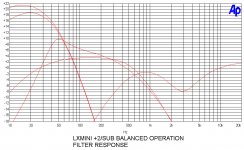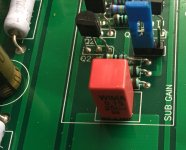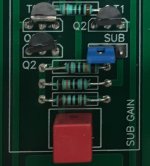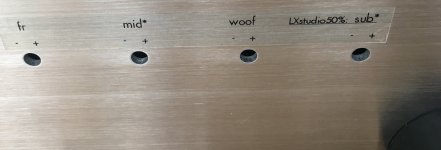A few set up tips for DIY-builders of Nelson Pass´ balanced 3-way ASP for LXmini / LXmini+2 / LXstudio / LXsirius.
Current pcb version is "BAL-LXMINI-SUB R2, 2018 PASSWORKS"
https://www.magiclx521.com/epages/1...ctPath=/Shops/17940394/Products/"ASP mini NP"
How to setup the ASP between your music source and your amplifiers?
LXmini/LXsirius operation :
Use Fullrange (FR) channel to feed the amplifier for the Fullrange driver FU-10
Use Woofer (WOF) channel to feed the amplifier for the Woofer driver L16RN
LXmini+2/LXsirius+2 operation :
Use Fullrange (FR) channels to feed the amplifier for the Fullrange drivers FU-10
Use Midwoof (Mid) channels to feed the amplifier for the Woofer drivers L16RN
Use Subwoofer (Sub) channels to feed the LXsub2 woofers
LXstudio operation :
Use Fullrange (FR) channels to feed the amplifier for the Fullrange drivers FU-10
Use Midwoof (Mid) channels to feed the amplifier for the Woofer drivers L16RN.
Use Subwoofer (Sub) channels to feed the LXsub4 woofers,
but reduce the woofer outputs by 50% (trimpots to 1/2 in sub channels).
Note that best performance is obtained when the outputs that are not used are turned down – for example with the +2 and Studio version the “woofer” output would be turned down. For the LXmini (2-way) the “mid” and “sub” would be turned down. This prevents any noise/distortion from unused circuits clipping.
Enjoy!
Frank
Current pcb version is "BAL-LXMINI-SUB R2, 2018 PASSWORKS"
https://www.magiclx521.com/epages/1...ctPath=/Shops/17940394/Products/"ASP mini NP"
How to setup the ASP between your music source and your amplifiers?
LXmini/LXsirius operation :
Use Fullrange (FR) channel to feed the amplifier for the Fullrange driver FU-10
Use Woofer (WOF) channel to feed the amplifier for the Woofer driver L16RN
LXmini+2/LXsirius+2 operation :
Use Fullrange (FR) channels to feed the amplifier for the Fullrange drivers FU-10
Use Midwoof (Mid) channels to feed the amplifier for the Woofer drivers L16RN
Use Subwoofer (Sub) channels to feed the LXsub2 woofers
LXstudio operation :
Use Fullrange (FR) channels to feed the amplifier for the Fullrange drivers FU-10
Use Midwoof (Mid) channels to feed the amplifier for the Woofer drivers L16RN.
Use Subwoofer (Sub) channels to feed the LXsub4 woofers,
but reduce the woofer outputs by 50% (trimpots to 1/2 in sub channels).
Note that best performance is obtained when the outputs that are not used are turned down – for example with the +2 and Studio version the “woofer” output would be turned down. For the LXmini (2-way) the “mid” and “sub” would be turned down. This prevents any noise/distortion from unused circuits clipping.
Enjoy!
Frank
3-way ASP Nelson Pass, RCA or XLR plugs
[SIZE=+1]PLUGS for the 3mm alu case[/SIZE]
Depending on your preference, you may run it either with RCA plugs or XLR plugs.
Twisted cable pairs are recommended.
The cases cutouts allow for either one , all are quality plugs from Neutrik:
RCA/Cinch would need (2x for inputs, 8x for outputs)= 10x Neutrik NF2D
NF2D-9 | Neutrik
where you may choose between different colors for housing and isolation ring
Standard would be red for right channel, white for left channel
Connect RCA center to "+" on the board
Connect RCA ring to "G" on the board
If you prefer balanced with Neutrik XLRs, you may use
2x for input NC3FD-V (silver or NC3FD-V-B (black) NC3FD-V | Neutrik
8x for output NC3MD-H (silver) NC3MD-H-B (black) NC3MD-H | Neutrik
Always connect 2 (hot) and 3 (cold) from board to the XLR plug
Connect all XLR plugs #1 directly to XLRplug housing (and by this to the case)
(Additionally , there is a gounding point (M4 srew) at the rear face of the aluminum case,
where you may do additional grounding connection to your poweramp/preamp/player.)
[SIZE=+1]PLUGS for the 3mm alu case[/SIZE]
Depending on your preference, you may run it either with RCA plugs or XLR plugs.
Twisted cable pairs are recommended.
The cases cutouts allow for either one , all are quality plugs from Neutrik:
RCA/Cinch would need (2x for inputs, 8x for outputs)= 10x Neutrik NF2D
NF2D-9 | Neutrik
where you may choose between different colors for housing and isolation ring
Standard would be red for right channel, white for left channel
Connect RCA center to "+" on the board
Connect RCA ring to "G" on the board
If you prefer balanced with Neutrik XLRs, you may use
2x for input NC3FD-V (silver or NC3FD-V-B (black) NC3FD-V | Neutrik
8x for output NC3MD-H (silver) NC3MD-H-B (black) NC3MD-H | Neutrik
Always connect 2 (hot) and 3 (cold) from board to the XLR plug
Connect all XLR plugs #1 directly to XLRplug housing (and by this to the case)
(Additionally , there is a gounding point (M4 srew) at the rear face of the aluminum case,
where you may do additional grounding connection to your poweramp/preamp/player.)
I seem to remember that at one point you mentioned that you would release a 3-way
asp for LXmini +2 - has that project been abandoned or is it still under way?
It is still underway, that is to say it's on the big list. Next up is the 6-24
dB adjustable biamp.
The 3 way LXmini from MagicLX521 is available as kit or finished product,
however it is not the one which will appear in the store. It has balanced
and single-ended inputs and outputs and extra circuits so that a
consumer can easily switch between LXmini, LXmini+2 and LXmini Studio
versions without opening the chassis.
The simpler diyAudio version is not balanced and has about half the
circuitry and board space. Two of them can be operated balanced, but
they do not convert balanced to unbalanced or vice versa. By virtue of
the simplicity, it is less expensive.

LXsirius
Hello tubesguy,
LXsirius is the turnkey brother of the LXmini-DIY-kit. 404 Not Found
LXsirius is based on the acoustical concept of LXmini, with some development in the appearance, e.g.:
No rubber coupler
The front aspect of its body is quite slim for a fullrange floorstanding speaker: <9cm>
Best
Frank
Hello tubesguy,
LXsirius is the turnkey brother of the LXmini-DIY-kit. 404 Not Found
LXsirius is based on the acoustical concept of LXmini, with some development in the appearance, e.g.:
No rubber coupler
The front aspect of its body is quite slim for a fullrange floorstanding speaker: <9cm>
Best
Frank
I have a question about the balanced board.
On each side, in the Input column, there is the 3-hole "SUB" in the subgain sub-circuit near the transistors.
I assume this is for the 3-pin male header and the kobiconn jumper. How is this configured in operation?
Thanks in advance,
--Mark
On each side, in the Input column, there is the 3-hole "SUB" in the subgain sub-circuit near the transistors.
I assume this is for the 3-pin male header and the kobiconn jumper. How is this configured in operation?
Thanks in advance,
--Mark
I assume this is for the 3-pin male header and the kobiconn jumper. How is this configured in operation?
Thanks in advance,
--Mark
Hello Mark,
yes, the jumper setting allows you to activate a sub/rumble filter.
If you prefer, you may also wire a switch to both "SUB" positions.
Best,
Frank
LXsirius is the turnkey brother of the LXmini-DIY-kit. 404 Not Found
Link broken, try this: LXsirius: MagicLX
Hi Mark,
no jumper or jumper parked - no filter,
jumper installed - high pass filter (rumble filter) active.
I ll have to recheck on the board , which side is "park" and which is "active".
The orientation of the jumper should be obvious when playing music with low freq content or a 20Hz test tone.
Best, Frank
no jumper or jumper parked - no filter,
jumper installed - high pass filter (rumble filter) active.
I ll have to recheck on the board , which side is "park" and which is "active".
The orientation of the jumper should be obvious when playing music with low freq content or a 20Hz test tone.
Best, Frank
Link broken, try this: LXsirius: MagicLX
Wow! That's very nice. Would eliminate a lot of comments I get from people who think that the Minis are some type of plumbing fixture for very small people.
Nelson, got it...and a hidden bonus feature!
Tubesguy, it's that rubber coupler that puts it firmly in the plumbing category. I can disguise the pipe pretty well, but that rubber coupler jumps out at you. For better or worse, it is perfect for the job...SL knew exactly what he was doing... without breaking the bank. Brilliant, practical engineering.
Tubesguy, it's that rubber coupler that puts it firmly in the plumbing category. I can disguise the pipe pretty well, but that rubber coupler jumps out at you. For better or worse, it is perfect for the job...SL knew exactly what he was doing... without breaking the bank. Brilliant, practical engineering.
Rear photo of enclosure
See the rear photo of a finished 3-way balanced ASP
The plugs may be either balanced XLR or unbalanced RCA
The plugs may be mounted from outside or from inside.
The photo shows XLR mounted from outside.
See the rear photo of a finished 3-way balanced ASP
The plugs may be either balanced XLR or unbalanced RCA
The plugs may be mounted from outside or from inside.
The photo shows XLR mounted from outside.
Attachments
For LXmini / LXsirius operation connect fr and wof
For LXmini+2 / LXsirius+2 operation connect fr and mid and sub
For LXstudio operation connect fr and mid and sub , reduce sub pot to 50%
The pots are located on lower side and may be turned with a screwdriver (case closed)
For LXmini+2 / LXsirius+2 operation connect fr and mid and sub
For LXstudio operation connect fr and mid and sub , reduce sub pot to 50%
The pots are located on lower side and may be turned with a screwdriver (case closed)
Attachments
I just finished mine. It replaced the MiniDSP 4 x 10 in a LXMini+2 configuration. I originally bought the LXMinis for mixing audio, because my wife thought the monitors I had were muddy on her piano recordings, which they were. We’re amateurs, but the goal is the best recording possible and we love great music.
Most of my microphones are DIY kit copies of classic mics (Neumann and Schoeps copies from Microphone Parts or via Groupdiy.com, etc), or DIY upgrades of commercial mics with good properties (e.g., Oktava MK-012). You really hear the limitations of your signal chain, the instrument, (and your room) when you record a single instrument in stereo and listen to the recording relatively unprocessed. Since you hear the original source as it is being recorded, the difference in playback is striking.
I could always hear the difference between the MiniDSP and the Metric Halo interfaces that we use for recording, especially on sounds with fast transients.
The difference with the ASP is unbelievable! None of the fuzzy overtones on instruments where pick attack is important (banjo, guitar, mandolin), cymbals sound more natural, etc. Surprisingly, the bass from the sub sounds better, but I suspect it is because the high frequency detail in low frequency instruments is rendered more clearly.
This is a total home run...thank you! (And I’ll use the MiniDSP and a reference mic as tools to design an active analog crossover for those old monitors...nothing is lost).
I raise a glass to you, sir!
—Mark
Most of my microphones are DIY kit copies of classic mics (Neumann and Schoeps copies from Microphone Parts or via Groupdiy.com, etc), or DIY upgrades of commercial mics with good properties (e.g., Oktava MK-012). You really hear the limitations of your signal chain, the instrument, (and your room) when you record a single instrument in stereo and listen to the recording relatively unprocessed. Since you hear the original source as it is being recorded, the difference in playback is striking.
I could always hear the difference between the MiniDSP and the Metric Halo interfaces that we use for recording, especially on sounds with fast transients.
The difference with the ASP is unbelievable! None of the fuzzy overtones on instruments where pick attack is important (banjo, guitar, mandolin), cymbals sound more natural, etc. Surprisingly, the bass from the sub sounds better, but I suspect it is because the high frequency detail in low frequency instruments is rendered more clearly.
This is a total home run...thank you! (And I’ll use the MiniDSP and a reference mic as tools to design an active analog crossover for those old monitors...nothing is lost).
I raise a glass to you, sir!
—Mark
- Home
- Amplifiers
- Pass Labs
- Balanced 3-way ASP NelsonPass




